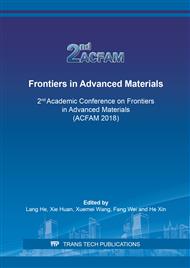p.273
p.282
p.294
p.305
p.317
p.324
p.332
p.342
p.352
Study on the Viscosity and Affinity of Epoxy Resin Chemical Grouting Material Considering Time Variation
Abstract:
In this paper, the CW epoxy resin grouting material produced by Changjiang River Scientific Research Institute was choosed as the research object. By testing the viscosity, surface tension and contact angle of the epoxy grouting material, the change law of the viscosity and affinity of the curing process was investigated. The results show that the viscosity, surface tension and contact angle of the slurry decreased with the time increased. The surface tension value of slurry is the maximum when its viscosity is the minimum. The trend of the surface tension change showed a rapid growth and then tended to be stable. When the curve is stable, the surface tension value is the equilibrium surface tension of the slurry. Through the calculation and analysis, the mathematical model of viscosity and affinity of CW epoxy resin was established.
Info:
Periodical:
Pages:
317-323
Citation:
Online since:
June 2019
Authors:
Price:
Сopyright:
© 2019 Trans Tech Publications Ltd. All Rights Reserved
Share:
Citation:


